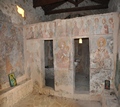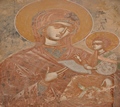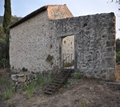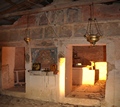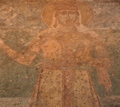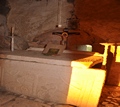
In the village of Kamara, south of Kastellani, about 10 km from the country, is the Monastery of Agios Vlasios. It is a Byzantine monastery of the 13th century, which was rebuilt during the Venetian period, preserving parts of the earlier monastery. There are also architectural elements of an ancient Greek (Doric capital on the holy bank) and an early Christian temple that indicate the existence of an ancient sanctuary and then an early Christian basilica. Inside the stone-built one-room church with a three-sided arch, frescoes from various periods with representations of the Virgin Mary, the Apostles, St. Blasios (in the iconostasis) and various Saints (in the narthex) are preserved in moderate condition. In the step, some figures of Saints can be seen with difficulty, while part of a marble slab is preserved. The entrance to the temple is on the south wall. In the masonry of the apse of the sanctuary and on the south wall, brick eight-pointed stars and bricks placed diagonally can be seen, which are characteristic of Byzantine church building. Also around the south and west walls is preserved a parapet bearing parts of a tombstone and certifying that the church was a monastery. St. Blasios the miracle worker (Archbishop Sebastias), who was martyred in the time of Licinius (265-325), is considered a physician for those suffering from throat ailments. On his feast day, February 11, the faithful are offered a watermelon that refers to the miracle of healing the children of Corfu from a deadly epidemic of throat disease. It is also said that, northeast of the temple of Agios Vlasios, the place is a meeting point for ghosts and spirits. Also around the south and west walls is preserved a parapet bearing parts of a tombstone and certifying that the church was a monastery. St. Blasios the miracle worker (Archbishop Sebastias), who was martyred in the time of Licinius (265-325), is considered a physician for those suffering from throat ailments. On his feast day, February 11, the faithful are offered a watermelon that refers to the miracle of healing the children of Corfu from a deadly epidemic of throat disease. It is also said that, northeast of the temple of Agios Vlasios, the place is a meeting point for ghosts and spirits. Also around the south and west walls is preserved a parapet bearing parts of a tombstone and certifying that the church was a monastery. St. Blasios the miracle worker (Archbishop Sebastias), who was martyred in the time of Licinius (265-325), is considered a physician for those suffering from throat ailments. On his feast day, February 11, the faithful are offered a watermelon that refers to the miracle of healing the children of Corfu from a deadly epidemic of throat disease. It is also said that, northeast of the temple of Agios Vlasios, the place is a meeting point for ghosts and spirits. he is considered a physician for those suffering from throat ailments. On his feast day, February 11, the faithful are offered a watermelon that refers to the miracle of healing the children of Corfu from a deadly epidemic of throat disease. It is also said that, northeast of the temple of Agios Vlasios, the place is a meeting point for ghosts and spirits. he is considered a physician for those suffering from throat ailments. On his feast day, February 11, the faithful are offered a watermelon that refers to the miracle of healing the children of Corfu from a deadly epidemic of throat disease. It is also said that, northeast of the temple of Agios Vlasios, the place is a meeting point for ghosts and spirits.
Editor: Niki Kalopaidis








